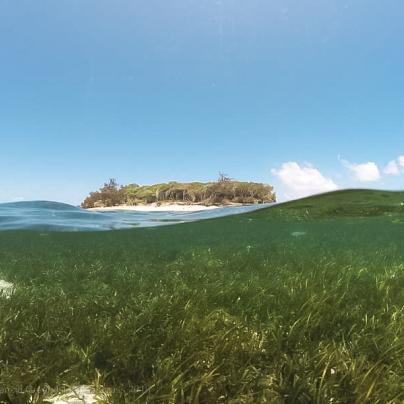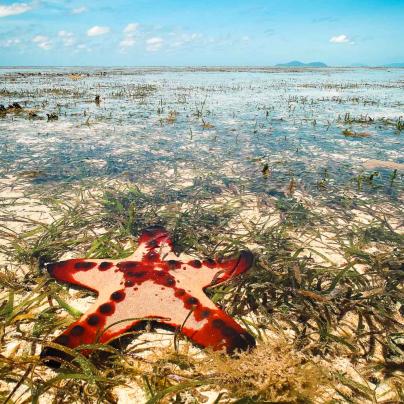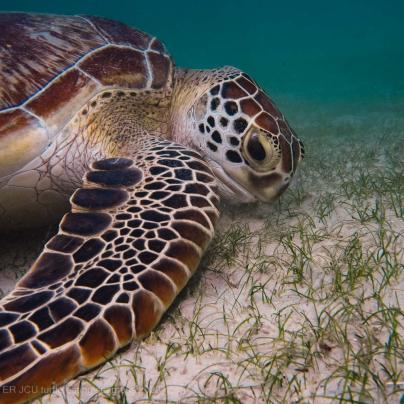Key environmental pressures 2023-24
Pressures affecting inshore Reef seagrass habitats varied across regions and habitats during 2023-24.
Cyclone Jasper impacted inshore seagrass in Cape York and the northern Wet Tropics regions, and Cyclone Kirrily impacted seagrass habitat in the Burdekin region. Both cyclones brought considerable rainfall, particularly in the northern regions, with more acute physical disturbances to the Burdekin region.
In the northern regions, during the 2023-24 wet season, turbid waters were observed extending further offshore than the long-term average, exposing a greater area of seagrass to these conditions.
The southern Mackay-Whitsunday and Burnett-Mary regions both experienced river discharges that exceeded long-term medians.
Benthic light availability was below the long-term average for inshore Reef seagrass meadows.
Within-canopy water temperatures are one of the most significant environmental pressures impacting inshore Reef seagrass meadows. In the 2023-24 monitoring period, within-canopy temperatures remained above average for the third consecutive year. In the Fitzroy region, the number of extreme heat days (days >40 °C) were the highest since the monitoring was established with the hottest seawater temperature ever recorded of 50.8°C at Shoalwater Bay.
Read the latest Marine Monitoring Program Annual Inshore Seagrass Report 2023–24.
How did inshore seagrass respond?
Reef-wide seagrass condition for inshore seagrass meadows remained in an overall ‘moderate’ condition in 2023-24.
- In the Cape York region:
- Inshore seagrass communities remain in an overall ‘moderate’ condition.
- Seagrass abundance scores declined from the previous period to the lowest levels since monitoring commenced.
- The resilience indicator remained ‘poor’. Coastal sites experienced a slight increase whereas reef site scores were the lowest recorded.
- In the Wet Tropics region:
- The overall inshore seagrass condition in this region declined to ‘poor’.
- In the northern sites, seagrass abundance and resilience scores deteriorated due to the adverse climatic and environmental conditions affecting this sub-region.
- The southern sites had a low seagrass abundance and a decline in resilience. Recovery in this sub-region has been challenged since 2011.
- In the Burdekin region:
- Seagrass communities deteriorated to an overall ‘poor’ condition.
Seagrass abundance slightly decreased relative to the previous period, mainly due to the impacts of Cyclone Kirrily.
Seagrass resilience significantly decreased to ‘poor’ for the first time since 2013-14.
- In the Mackay-Whitsunday region:
- Inshore seagrass meadows slightly declined in overall condition remaining ‘moderate’.
- The seagrass abundance score increased marginally remaining at ‘moderate’, driven by increases in reef intertidal and subtidal habitats.
- The resilience score declined but remained ‘moderate’ for the third year in a row.
- In the Fitzroy region:
- The overall seagrass condition score slightly improved but remained ‘poor’.
- Seagrass abundance score improved from the previous period, achieving its highest score since 2009-10.
- Findings on resilience showed an improvement in condition but remained ‘poor’.
- For the first time since the 2019-20 period, inshore seagrass meadows in the region have shown signs of improvement.
- In the Burnett-Mary region:
- Seagrass in this region improved to an overall ‘poor’ condition.
- The seagrass abundance score improved significantly to ‘moderate’. This was the first improvement since 2018-19 and the highest score recorded for this region since the MMP began.
- While resilience improved slightly it remained ‘poor’ overall in the region.
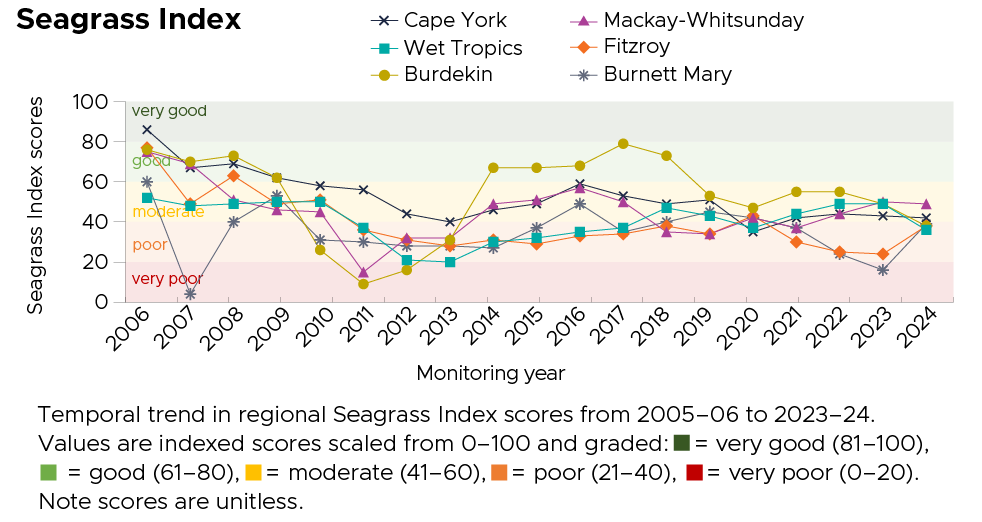
What is monitored?
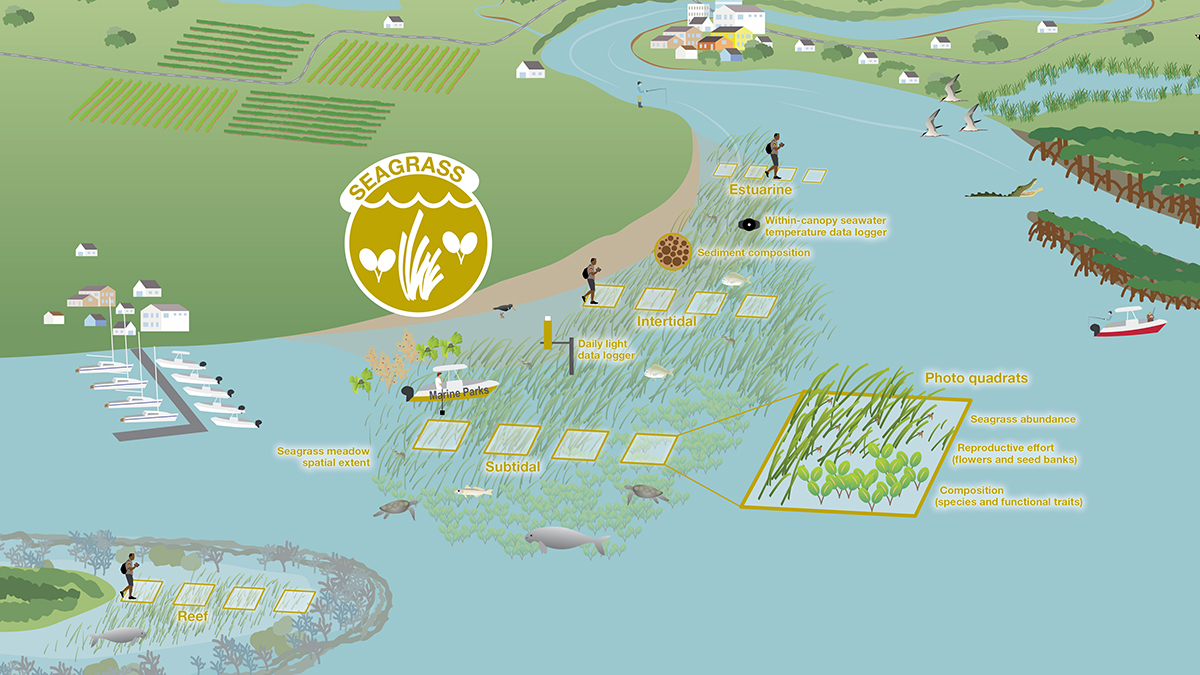
Inshore seagrass meadows are monitored at sites in four types of habitats: estuarine, coastal intertidal and subtidal, and reef intertidal.
- At these sites, seagrass monitoring is conducted by assessing the following indicators:
- Abundance as per cent cover
- Resilience metric incorporating species composition and reproductive status (full details of the resilience metric can be found in the Resilience in practice report)
In addition to these indicators, seagrass species, the size and patchiness of the seagrass meadows, and the density of seeds in the seed bank are also assessed.
Factors that can affect seagrass conditions are recorded, which include within-canopy seawater temperature, the amount of light reaching the plants, the sediment characteristics, and the abundance of macroalgae and epiphytes.
- Where is seagrass condition monitored?
- Cape York
- Wet Tropics
- Burdekin
- Mackay-Whitsunday
- Fitzroy
- Burnett-Mary
- Read the Marine Monitoring Program Annual Inshore Seagrass Report 2023-24
- Learn more about the seagrass monitoring methods in the Marine Monitoring Program Annual Report Quality Assurance and Quality Control Manual 2023-24.
- Additional site-level information can be found in the Seagrass Watch website.
